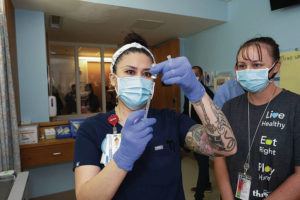The state Department of Health on Friday released an updated summary of its COVID-19 vaccination plan on how the vaccine will eventually be made available to all Hawaii residents by the end of the summer.
Since mid-December, the state and its partners have been administering vaccines under Phase 1-A of the plan, which includes health workers at hospitals and residents and staff at long-term care facilities. It is estimated that these categories make up about 6% of Hawaii’s population of about 1.4 million.
On Friday night, the department said more than 35,000 vaccinations had been administered across the country and that Hawaii had received 91,700 vaccine doses across the country, with another 17,550 orders to be delivered next week.
Phase 1-B includes kupuna 75 and above, along with frontline employees, including correctional officers, educators and critical transportation and utility workers, who are estimated to be about 20% of Hawaii’s population.
The department did not have specific dates for the implementation of Phase 1-B, but said details on how seniors aged 75 and older can register for vaccinations can only be expected next week. In addition, the locations and opening dates of major pods – or delivery points – of the vaccinations will be announced soon.
Phase 1-C includes the ages 65 to 74, along with persons 16 to 64 with high-risk medical conditions, as well as other essential workers, who are estimated to be about 47% of the state population.
Eventually, Phase 2 will include the rest of the population – anyone over 16 who were not in any of the previous categories – which is expected to start in early summer, depending on the federal allocation of doses.
The department said based on the estimated number of people in each of these priority groups, 73% of the state’s population will receive the vaccination by completing Phase 1, while the remaining 27% will be covered in Phase 2.
The phases may also overlap, and in each phase, the oldest residents will be given first priority, the department said.
“We continue to devote our full attention to ensuring a robust and orderly implementation of our vaccination program,” said Dr. Libby Char, state health director, said in a news release. ‘Our plan favors the vaccine for those who come into direct contact with the virus and those who are at higher risk for serious COVID-19 infections and disability or death. The safe and orderly roll-out ensures that we work efficiently to minimize wastage of doses and to improve patient safety. ”
Some hospitals are preparing to make COVID-19 vaccines available to their patients.
Kaiser Permanente is currently vaccinating its health workers, who are receiving their second set of shots from the Pfizer vaccine, as well as independent health workers who do not necessarily have to be members, in collaboration with the Department of Health.
Dionicia Lagapa, director of clinic operations at Kaiser, said preparations are underway to notify those in the Phase 1-B category next week of the availability of the vaccine, with a target date of 18 January.
She said Kaiser will use an e-ticket or e-visit system for its members, who can schedule appointments online, with other options for those without internet access. During the pandemic, she said many members, including kupuna, became familiar with online services and opportunities for telehealth.
Andrea Eshelman, deputy director of the Hawaii State Teachers Association, said educators and school workers in Kauai expect to be vaccinated as early as Monday, thanks to extra availability on Garden Island.
For teachers on other islands, the expected start date is late January or early February as part of Phase 1-B. More than 40,000 are expected to be vaccinated, she said.
The Kauai Health Care Office said more than 3,000 people on Garden Isle had received their first dose of COVID-19 vaccine and that hospitals there would announce detailed plans for the 75-year-old on Monday.
After officers in Kauai County presented the vaccines to educators and child care workers Monday, the vaccine will be available later this month for essential workers in food and agriculture, manufacturing, grocery stores and the postal service.
Government David Ige said on Spotlight Hawaii on Friday that so far he thought the vaccination of vaccines went smoothly.
“I think the vaccination of vaccines went very well on the islands,” Ige said during the spotlight interview. “Of course we want more vaccinations. We know there is a lot of anxiety, and we want to get people vaccinated as soon as possible. ”
Part of the challenge of the rollout, he said, is that the state gets short notice of quantities to be delivered weekly. The state finds out on Thursdays how much will be delivered next Monday or Tuesday.
Lt. Governor Josh Green on Thursday urged residents to post a temporary break at any two-week social gathering, saying an increase in vaccinations is expected in mid-January.
On Thursday, the state reached a record high for the new year, with 322 newly confirmed cases. This was the highest since mid-August, when the number rose to 355, and is mainly attributed to holidays. On Friday, the number of cases remained high, with 264 infections, with four more deaths, which increased the state’s total since the start of the pandemic to 22,895 cases and 303 deaths.
